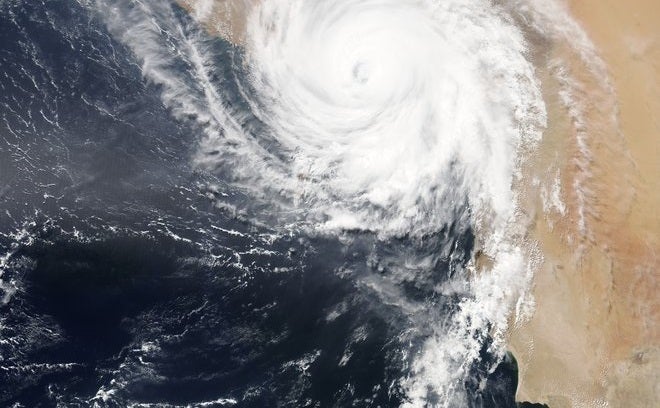Over the past 21 years, Haiti has been hit by 40 cyclones, thunderstorms and heavy rains. Each year on average two events cause flooding and landslides with serious consequences for people and their livelihoods.

Haiti is more vulnerable than many nations because of the number of people living in poverty. Climate change means that these phenomena could increase in occurrence and severity.
It is not possible to avoid natural disasters altogether – but two research papers for the project Haiti Priorise examine ways to reduce vulnerability and increase resilience.
In many countries, the Armed Forces are a vital part of any disaster relief plan. In Haiti, defense policy has been much discussed, especially because of the presence and departure of the Blue Helmets through the United Nations Haitian Stabilization Mission (MINUSTHA). Questions of sovereignty and territorial defense are ultimately political, not economic – but Economist-Planner and Project Analyst Rudy Joseph at the Ministry of Planning and External Cooperation contributes a useful input to the discussion, in the form of a benefit-cost analysis of the re-introduction of an Armed Forces.
The 1987 Constitution and its amended version presented the two operational components of defense policy, namely the Armed Forces of Haiti (FAD'H) and the National Police of Haiti (PNH). However, since 1995 only the PNH has been operational. The establishment of an Armed Forces has begun with the training and deployment of military engineers.
Dr. Joseph studies the cost and benefit of establishing a military organization consisting of three corps: army, navy and air force, with a target of 6,500 military personnel by 2050. This force will be given the mission of defending the territory, protecting sensitive environmental areas, and responding to natural disasters.
The costs associated with the establishment of armed forces are substantial. This would require the construction or redevelopment of military infrastructure, training, acquisition of uniforms, armaments, materials and equipment, and operating costs including salary, food, fuel, electricity, and maintenance.
Construction, operations, maintenance and redevelopment would over the next decades cost 22.1 billion gourdes. Territorial defense would cost another 5.6 billion gourdes, and monitoring of protected areas 1.5 billion gourdes. The total price-tag would be 29.2 billion gourdes.
For a country already facing heavy financial burdens, this large expense would pose a challenge. However, there would be benefits. It would help the General Customs Administration (AGD) to reduce its losses at land borders. Each year, the AGD's annual losses are estimated at more than 19 billion gourdes, due to inadequate surveillance of the border with the Dominican Republic. Dr. Joseph estimates that the presence of armed forces would recover up to 43,882.9 billion gourdes from 2017 to 2050.
Armed forces could also be a key element in the fight against deforestation. Armed forces could help to contribute to the protection of forested spaces defined by the Ministry of the Environment. Dr. Joseph estimates that this would allow savings of up to 5.9 million gourdes in carbon emissions over the reporting period.
Finally, the armed forces would be able to evacuate people in the event of natural disasters. Thus the establishment of armed forces could contribute to the reduction of loss of human life. In monetary terms, Dr. Joseph estimates that this would be worth 1.5 billion gourdes.
In total, creating the Armed Forces as described by Dr. Joseph would generate benefits to Haitian society worth 45.4 billion gourdes, meaning that every gourde spent would have positive impacts worth 1.6 gourdes.
Consultant George Granvorka studies other approaches to reducing Haiti’s vulnerability to natural disasters: implementing an Early Flood Warning System (SAPI) in the 65 municipalities at risk of flooding, and combining this with Multifunction Shelters to protect people and livestock.
Over the long term, Dr. Granvorka finds that these programs will not only save lives and livelihoods, but also ensure the government can better anticipate the effects of climate change. People will not suffer the massive financial shocks that are typical after a serious natural disaster. This will reduce poverty and lead to greater economic growth.
Dr. Granvorka estimates the cost of setting up an early-warning system would be 1.7 billion gourdes – a relatively small sum. The largest cost – 216 million gourdes per year for three years – is setting up natural disaster plans for 65 communes. Other costs would include training local volunteers (around 1.4 million gourdes per year) and salaries for engineers, technicians and secretaries (around 597,000 gourdes annually).
This system would save more than 290 lives each year. Put into financial terms – a way economists use to compare different types of benefits – these lives saved would be worth 12.9 billion gourdes to Haiti. It would also save peoples’ incomes, because they would be able to protect their livestock: chickens, cows and pigs. Dr. Granvorka estimates that this would be worth another 120 million gourds. This means that the total benefits of an early-warning system would be 13 billion gourdes, so every gourde spent would generate benefits worth 7.4 gourdes.
Adding 117 shelters to the early-warning system would mean more costs. The number of shelters is designed to take account of the number of people evacuated during the course of Hurricane Matthew. The average capacity of each shelter is 1,150 people and 450 animals.
It would cost 2.1 billion gourdes to build all the shelters, plus another 63 million gourdes in maintenance each year. More people and more livestock would be saved – an extra 275 lives and another 16.9 million gourdes worth of livestock each year – but because the costs are substantially higher, the overall return on the investment is smaller: every gourde of the 4.1 billion gourde investment would generate returns worth 4.2 gourdes to Haitian society.
Other Haiti Priorise research papers, which are designed to reduce poverty or improve infrastructure and health systems, can also be seen as ways of reducing vulnerability to natural disasters. There are various options – but ultimately, effective solutions need to be implemented, to increase the nation’s resilience to natural disasters.
